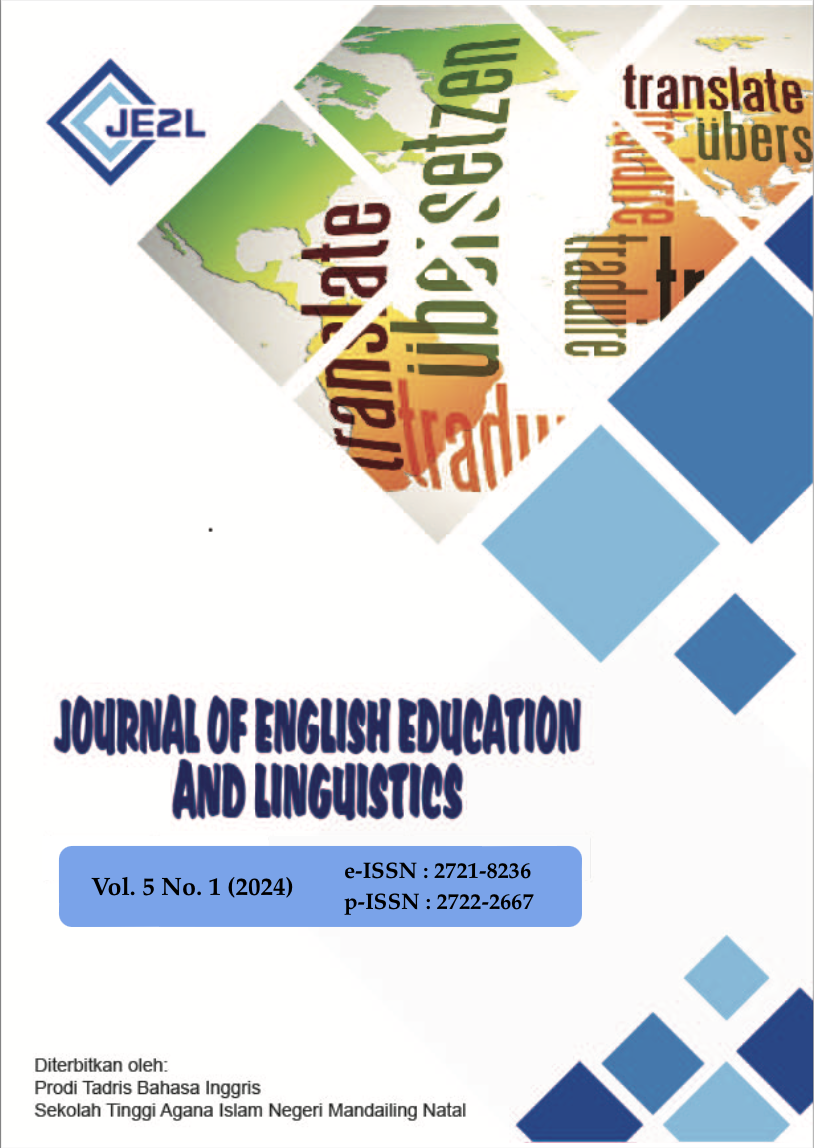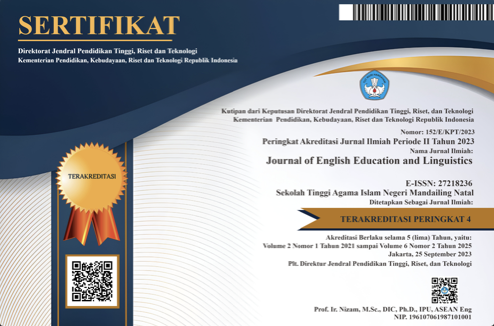ENGLISH NEEDS ANALYSIS FOR STUDENTS OF POLYTECHNIC RADIO DIAGNOSTIC ENGINEERING AND RADIOTHERAPY
DOI:
https://doi.org/10.56874/jeel.v5i1.1775Keywords:
English for Specific Purposes (ESP), needs analysis, English materialsAbstract
This study aims to identify and analyze the need for English for Specific Purposes (ESP) learning materials for students in the Department of Radio Diagnostic Engineering and Radiotherapy (ATRO) at Muhammadiyah Makassar. A needs analysis was conducted to ensure students receive materials that support their learning and career development, using a qualitative approach and descriptive strategy. The research subjects were second-semester students in class B21 and their experienced ESP lecturer, selected through purposive random sampling. Data collection involved observation, recording, questionnaires, and interviews. Key findings from the questionnaire included: 83.3% satisfaction with current ESP materials, 77.8% of students needing English related to Radiology, 55.6% with intermediate English proficiency, and 66.7% aiming to improve their English for professional purposes. Skills priorities were speaking (66.7%), listening (61.1%), reading (33.3%), and writing (33.3%). Effective speaking skills instruction is achieved by dividing the large class into three groups. These findings suggest ESP lecturers and stakeholders should develop lesson plans and teaching media aligned with these needs. Additionally, the ESP lecturer identified Merrill's Atlas of Radiographic Positions and Radiological Procedures as a key resource for material development.
References
Al-Hamlan, S., & Baniabdelrahman, A. A. (2015). A needs analysis approach to EFL syllabus development for second grade students in secondary education in Saudi Arabia : a descriptive analytical approach to students ’ needs. American International Journal of Contemporary Research, 5(1), 118–145. https://www.aijcrnet.com/journals/Vol_5_No_1_February_2015/15.pdf
Amda, F; Syamsuddin, S ; Erna, N. (2022). Analysis of the English Speaking Role and Barriers at Fort Rotterdam’s Staff. Enormous English Education Journal, 1(2), 102–110.
Aryanti, M. L. (2017). Students Interest in General English Class and Their Reaction Towards Teaching Methods. Indonesian EFL Journal, 3(2), 215–224. https://doi.org/10.25134/ieflj.v3i2.668
Boroujeni, S. A., Fard, F. M., & In, M. A. (2013). A Needs Analysis of English for Specific Purposes (ESP) Course For Adoption Of Communicative Language Teaching :( A Case of Iranian First-Year Students of Educational Administration). International Journal of Humanities and Social Science Invention ISSN, 2(6), 35–44. www.ijhssi.org
Chen, Y. P., Lee, H. F., & Wong, T. T. (2016). Epileptic seizure in primary intracranial sarcoma: a case report and literature review. Child’s Nervous System, 32(9), 1709–1714. https://doi.org/10.1007/s00381-016-3174-3
Chovancová, B. (2014). Needs analysis and esp course design: Self-perception of language needs among pre-service students. Studies in Logic, Grammar and Rhetoric, 38(51), 43–57. https://doi.org/10.2478/slgr-2014-0031
Ekayati, R., Manurung, I. D., & Yenni, E. (2020). Need Analysis of Esp for Non-English Study Program. Language Literacy: Journal of Linguistics, Literature, and Language Teaching, 4(2), 322–332. https://doi.org/10.30743/ll.v4i2.3152
Febriyanti, R. H. (2021). Autonomy Learning in The Praxis of Language Education: A Systematic Review. Hortatori : Jurnal Pendidikan Bahasa Dan Sastra Indonesia, 5(2), 155–165. https://doi.org/10.30998/jh.v5i2.755
Indrasari, N. (2016). English for Specific Purposes: A Need Analysis at The Second Semester of Physics Education Students of IAIN Raden Intan Lampung in The Academic Year of 2015/2016. English Education: Jurnal Tadris Bahasa Inggris, 9(1), 161–172. http://ejournal.radenintan.ac.id/index.php/ENGEDU/article/view/425
Khan, H. A. (2007). A needs analysis of Pakistani state boarding schools secondary level students for adoption of communicative language teaching. MA Diss. School of Arts & Education of Middlesex …. http://www.asian-efl-journal.com/thesis_Hamid_Ali_Khan.pdf
Long, B. W., Rollins, J. H., & Smith, B. J. (2018). M. A. of R., & Sciences., P. and P. E.-B. V. 3. E. H. (n.d.). SPd7DwAAQBAJ.pdf.
Masdianti, M. (2021). The Implementation of Teachers’ Humor in The Classroom. Seltics, 4(2), 110–120. https://doi.org/10.46918/seltics.v4i2.1017
Pranoto, B. E., & Suprayogi, S. (2020). A Need Analysis of ESP for Physical Education Students in Indonesia. Premise: Journal of English Education, 9(1), 94. https://doi.org/10.24127/pj.v9i1.2274
Trujeque-Moreno, E. E., Romero-Fernández, A., Esparragoza-Barragán, A., & Villa-Jaimes, C. J. (2021). Needs analysis in the english for specific purposes (ESP) approach: The case of the benemérita Universidad Autónoma de Puebla. Mextesol Journal, 45(2), 1–24.
Zahid Javid, C. (2015). English for Specific Purposes: Role of Learners, Teachers and Teaching Methodologies. European Scientific Journal, 11(20), 1857–7881.
Zambrano Chaves, J. M., Bhaskhar, N., Attias, M., Delbrouck, J. B., Rubin, D. L., Loening, A., Chaudhari, A. S., & Langlotz, C. (2023). RaLEs: a Benchmark for Radiology Language Evaluations. Advances in Neural Information Processing Systems, 36 (NeurIPS).
Downloads
Published
Issue
Section
License
All articles published in the Journal of English Education and Linguistics are licensed under a Creative Commons Attribution-ShareAlike 4.0 International (CC BY-SA) license. This means anyone is free to copy, transform, or redistribute articles for any lawful purpose in any medium, provided they give appropriate attribution to the original author(s) and Journal of English Education and Linguistics, link to the license, indicate if changes were made, and redistribute any derivative work under the same license.
Copyright on articles is retained by the respective author(s) without restrictions. A non-exclusive license is granted to the Journal of English Education and Linguistics to publish the article and identify itself as its original publisher, along with the commercial right to include the article in a hardcopy issue for sale to libraries and individuals.
Although the conditions of the Creative Commons Attribution-ShareAlike 4.0 International (CC BY-SA) license do not apply to authors (as the copyright holder of your article, you have no restrictions on your rights), by submitting to the Journal of English Education and Linguistics, authors recognize the rights of readers and must grant any third party the right to use their articles to the extent provided by the license.

This work is licensed under a Creative Commons Attribution-ShareAlike 4.0 International License.








